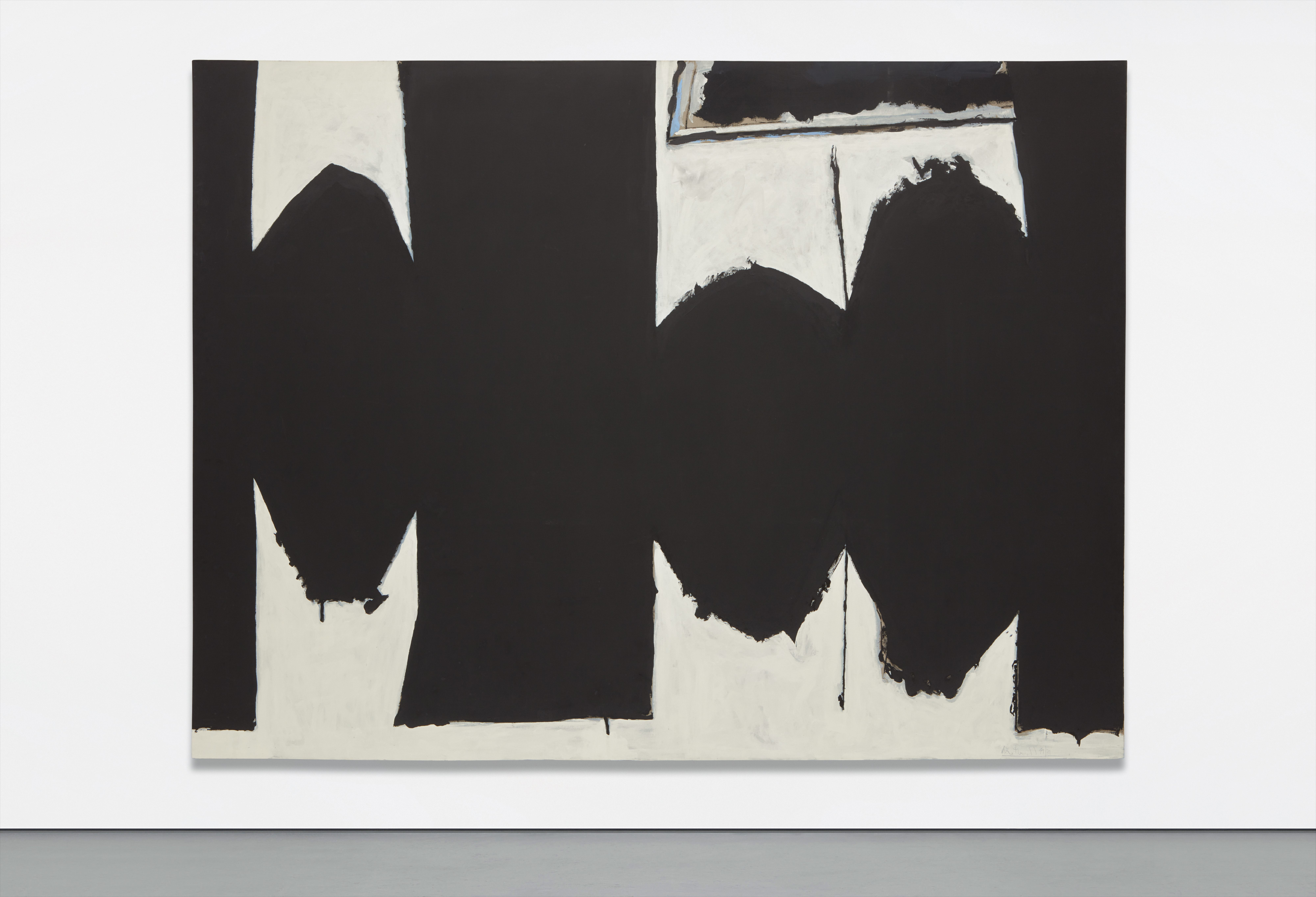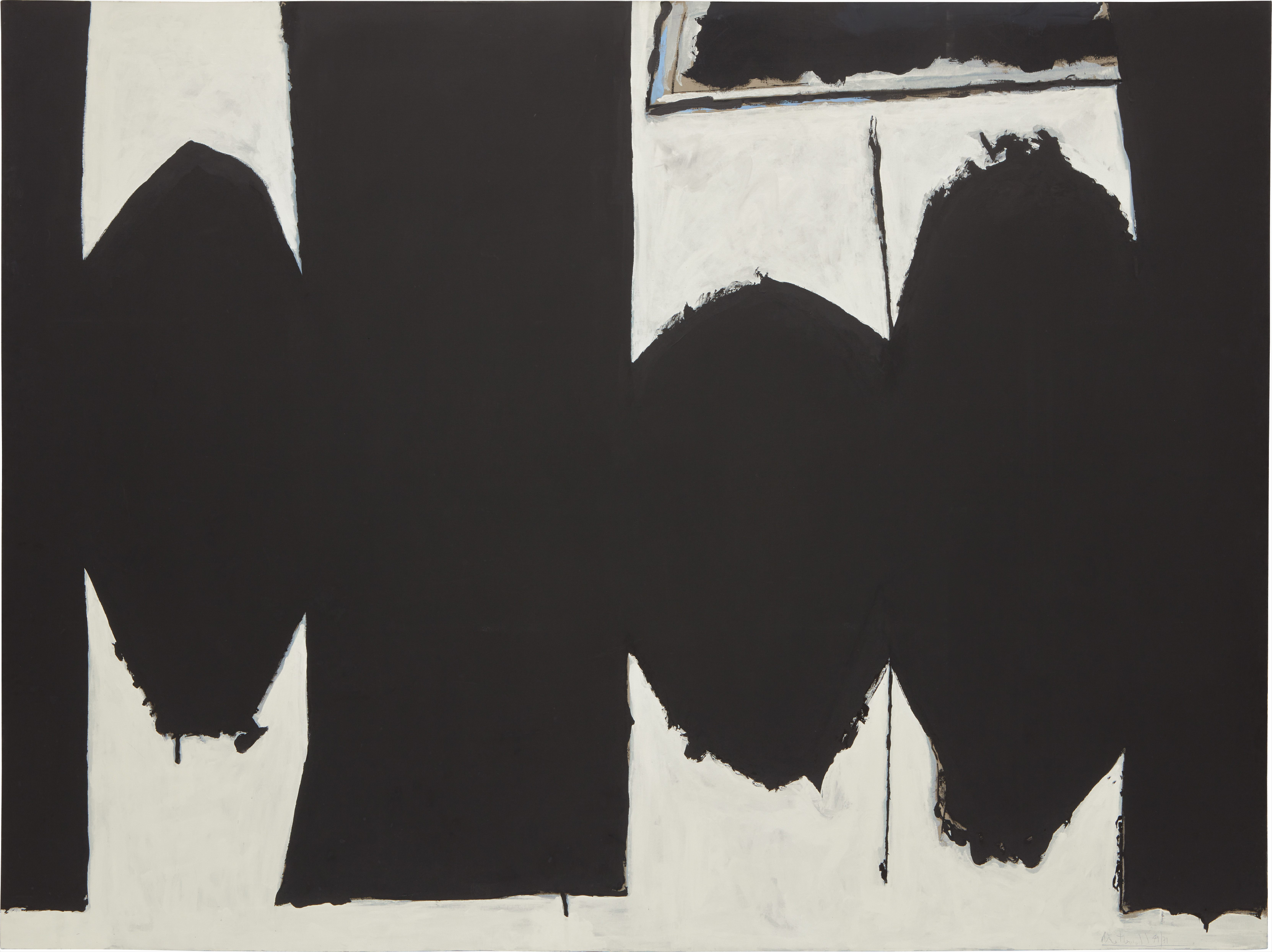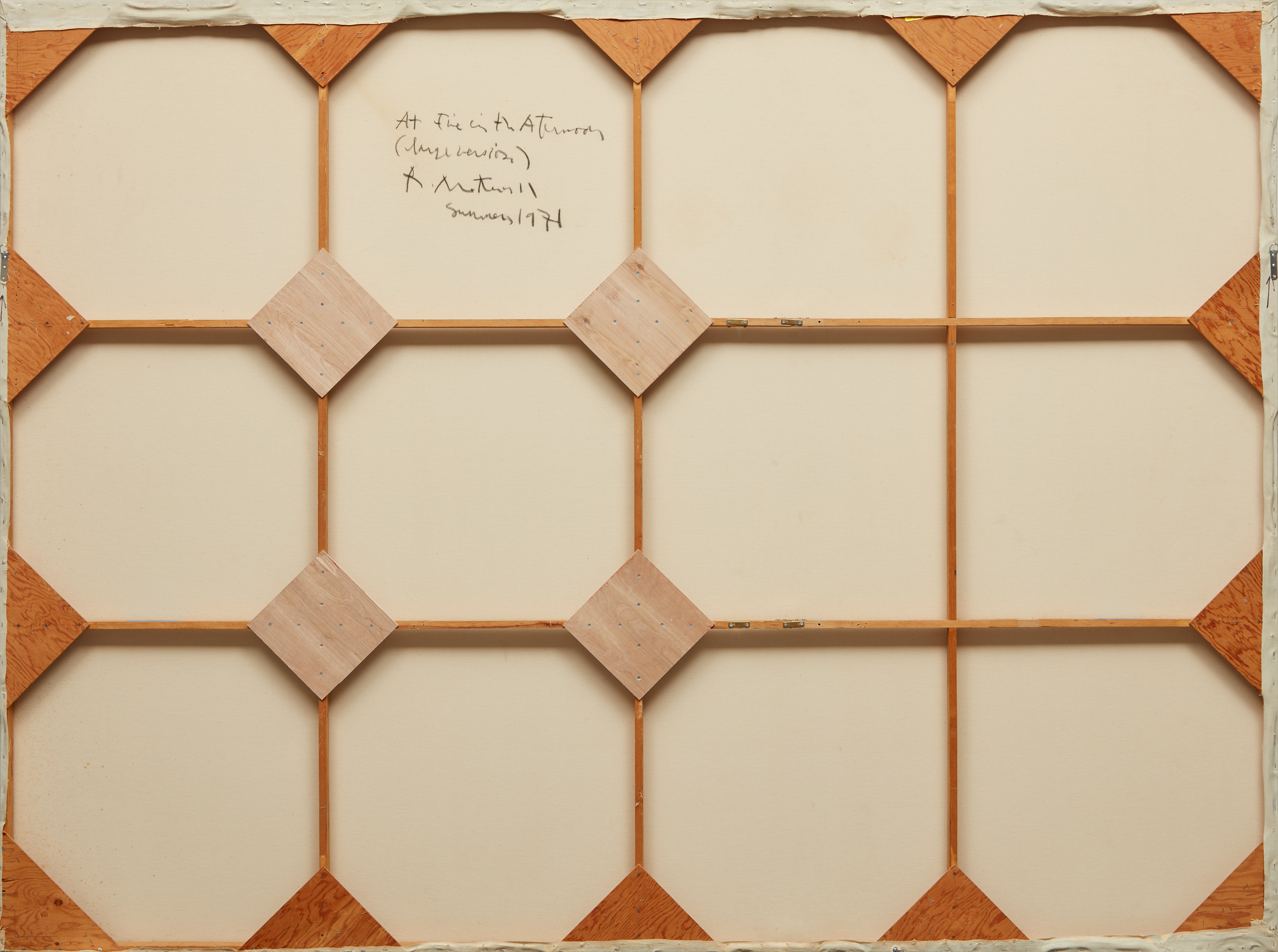







8Ο◆
Robert Motherwell
At Five in the Afternoon
Full-Cataloguing
Carter Ratcliff
Carter Ratcliff is a Contributing Editor at Art in America and the author of The Fate of a Gesture: Jackson Pollock and Postwar American Art.
Generating its power from contrasts at once stark and elegantly interwoven, Robert Motherwell’s At Five in the Afternoon, 1971, is among a handful of canvases crucial to the definition of Abstract Expressionism. As black and white find a complex equilibrium, geometry at its most austerely angular comes to terms with gesture at its most lushly organic. Grandeur draws strength from minute inflections. At Five in the Afternoon is a formal masterpiece, yet it is not an exercise in “pure painting” of the kind that certain modernists have sought since the 1890s. Motherwell described painting as a “search” not only “for beauty or artfulness, but an attitude toward reality” (Robert Motherwell, quoted in Robert Motherwell & the New York School: Storming the Citadel, dir. Catherine Tatge, Thirteen/WNET, 1991).
A brilliant writer with a background in literature and philosophy, Motherwell believed that “reality has a historical character” (Robert Motherwell, “The Modern Painter’s World,” 1940, in The Writings of Robert Motherwell, Berkeley, 2007, p. 28). He made this Hegelian principle his own by insisting that a pictorial possibility could be realized only over time, in successive paintings. Having established a theme, he would put it through the variations that produced such series as Open, Je t’aime, and Night Music. Of these, Elegy for the Spanish Republic is the most extensive. Over two-hundred and fifty works from small scale works on paper to monumental canvases—including the At Five in the Afternoon paintings—fall under this heading. Reflecting Motherwell’s era at every scale from the personal to the world-historical, the Elegies are endlessly resonant. For it is here that his deepest concerns are the most powerfully felt, and in the 1971 version of At Five in the Afternoon the artist’s feelings are given their fullest expression.
Referring to the hour at which bull fights traditionally begin, the painting’s title is taken from Federico García Lorca’s Lament for Ignacio Sánchez Mejías, a poem commemorating, with horror and exalted sorrow, a matador’s fatal goring in 1934 (Federico García Lorca, Lament for Ignacio Sánchez Mejías, in Robert Motherwell: Elegy to the Spanish Republic, exh. cat., Dominique Lévy, New York, 2016, pp. 22-29). Two years later, Lorca was assassinated. Though his killers have never been identified, it is widely agreed that they were right-wing operatives who targeted him for his support of the Spanish Republic and possibly because he was a homosexual. Under way by then, the Spanish Civil War ended in 1939 when a fascist coalition crushed its badly divided opposition. Francisco Franco became the head of a dictatorship that persisted until 1975. Twenty-one years old when the Civil War broke out, Motherwell felt a deep and immediate sympathy for those struggling to establish the Spanish Republic. Learning of their defeat, he underwent a corresponding shock.
The artist produced his first Elegy to the Spanish Republic in 1948. Executed in India ink on a small sheet of paper, it deploys three columns and three ovals. It the upper right-corner is a fragment of what may be a window frame. Appearing in the aftermath of the Second World War, this painting urges us to see the civil conflict in Spain as the prelude to a century of atrocities The Spanish Republic, in its demise, becomes a symbol of humane hope. Motherwell reprised the 1948 Elegy a year later. Naming it At Five in the Afternoon, he gave the dimension of an individual life to a widely inclusive symbol. The life in question is that of the slain bullfighter, Sánchez Mejías. However, we could see the exemplary figure as the poet Lorca. Or as Motherwell himself, who wrote that “the history of modern art tends at certain moments to become the history of modern freedom” (Robert Motherwell, “The Modern Painter’s World,” 1940, in The Writings of Robert Motherwell, Berkeley, 2007, p. 29). One of those moments occurred in 1949, triggered by the personal crisis that drove the artist to reprise his first Elegy and name the new painting At Five in the Afternoon. In 1971, the crisis recurred.
Motherwell married the painter Helen Frankenthaler in 1958, bringing to their union the 1949 version of At Five in the Afternoon. When they divorced in 1971, their settlement allowed her to keep the painting. Devastated by the loss of a work of such intensely personal significance, he decided to recreate it on a canvas ten feet wide and seven and a half feet high. The painting was going well until his mood suddenly changed. As he recalled the following summer, “I began to feel suicidal.” “Terribly upset,” he asked, “What am I hiding from myself?” Only after a long bout of anguished rumination did the answer come to him. He had made the earlier At Five in the Afternoon when his first wife, the Mexican actress Maria Ferriera y Moyers left him. Working on that painting, he had “seriously considered suicide,” and thoughts of killing himself returned as he remade the painting twenty-two years later (Robert Motherwell, quoted in “Interview with Martin Friedman and Dean Swanson”, August 1, 1972, Daedalus Foundation Archives, New York).
Independence, he realized, could be felt as unbearable isolation. Reprising At Five in the Afternoon in 1971, Motherwell felt himself drawn to the verge of self-destruction—and then back from that ultimate precipice. For, in finishing the painting, he reclaimed his best sense of himself.
Talking to David Sylvester in 1960, the artist said, “The process of painting is a series of moral decisions about the aesthetic.” He did not, he added, mean this “in a puritanical sense…but almost primitively, as a kind of animal thirst for something solidly real.” (Robert Motherwell, quoted in “Interview with David Sylvester”, in David Sylvester, Interviews with American Artists, New Haven, 2001, pp. 76-77). Of course, he wanted his paintings to “work” pictorially, as the New York painters began saying in the 1940s. Yet Motherwell was never satisfied with a narrow aesthetic success. Hence the Elegies. Recalling the horrors perpetrated in the name of ideology, these paintings immerse us in a felt sense of our shared history. And, as they point beyond our collective destiny to the fate of an individual, the Elegies entitled At Five in the Afternoon turn the dead matador of Lorca’s Lament into an emblem of the death that Motherwell, in moments of suicidal despair, hoped for himself. By completing the two paintings, he twice found his way beyond that despair to the generative power that charges every detail of Motherwell’s paintings with manifold meanings. For At Five in the Afternoon, especially the version from 1971, is haunted by more than the bullring’s fatal ritual.
Though the painting’s tall, geometric forms find echoes throughout the history of art, their most telling allusion is to Henri Matisse’s Bathers by a River, 1909-1910, The Art Institute of Chicago. Of all the Abstract Expressionists, Motherwell had the most sophisticated relationship with the School of Paris, as is shown by his transformation of the vertical divisions that supply the Bathers’s figures with a backdrop. For Matisse, these divisions are formal devices. In At Five in the Afternoon they are that and more: concise evocations of the architectural structures that house our civilization and, in doing so, provide us with an environment shaped by principles of order. By joining geometric with organic forms, this painting mixes the ideal with the contingent, the transcendent with reminders of historical events that have precipitated tragedy. Yet Motherwell gives us neither a single conclusion to draw nor just one emotion to feel. Though many commentators have interpreted the ovals and thrusting verticals of At Five in the Afternoon as the cojones and phallus of a fighting bull, the ovals could be seen as feminine—or, with the vitality of their outlines, as symbols of every life embodied in flesh. For all its dark overtones, this is a joyously realized painting, and its imposing scale invites us to see our humanity as heroic.
Though the 1971 version of At Five in the Afternoon reincarnates the one from 1949, these works are fundamentally different, not only in size but also in facture. The 1949 painting shows Motherwell’s command of the automatism that he and other Abstract Expressionists learned from the Surrealists exiled to New York by the Second World War. In 1971, he recapitulated all the spontaneous drips and feathered edges of 1949, giving the later painting a quality of willed determination. Nonetheless—and this is astonishing—the traces of his brush feel utterly liberated. Giving in to the necessity of making this painting, Motherwell freed himself.
Defiantly distinct, the Abstract Expressionists were preoccupied with their singular states of being. Jackson Pollock once said, “I am nature”—a boast that becomes believable when we see his dripped and spattered canvases as the work of a painter impersonating the impersonal forces of the natural world (Jackson Pollock, quoted in Jackson Pollock, New York, 1989, p. 159).
Describing his subject as “the terror of Self,” Barnett Newman turned toward an unknowable future in the hope that his feelings of absolute isolation might somehow be redeemed (Barnett Newman, 1965, in Barnett Newman: Selected Writings and Interviews, New York, 1990, p. 187). Clyfford Still, the most solitary of the Abstract Expressionists, declared in 1963 that, through his art, he had attained “total psychic unity.” He was whole. Others were “fractional” beings burdened by the hope that he might have something to communicate to them—a vain hope, according to Still. For him, isolation was the goal he sought and attained with each of his paintings (Clyfford Still, quoted in Clyfford Still 1904-1980: The Buffalo and San Francisco Collections, Kunsthalle Basel, 1992, pp. 156-162). Motherwell’s goal was something like the opposite.
Naturally, he found and maintained a uniquely Motherwellian way of making a painting. However, he never embraced the notion that an artist’s originality could separate his oeuvre from the world in which it appeared. His art engaged art history, world history, and the perennial questions posed by the immediacies of our lives. Understanding that these questions can never be given settled answers, he remained alive to uncertainty and thus, as he wrote in 1965, “One never really gets used to reality” (Robert Motherwell, “Letter to Frank O’Hara”, August 18, 1965, in Robert Motherwell, exh. cat., The Museum of Modern Art, New York, 1965, p. 59).
One must always confront it, grasp it, recreate it. By recreating the real on the artist’s most demanding terms, Five in the Afternoon ushers us into a state he once called “ecstasy”—Motherwell’s word, perhaps, for the experience of immersion in a field of inexhaustible meaning of the kind that this painting provides (Robert Motherwell, quoted in Reconciliation Elegy: A Journal of Collaboration, New York, 1980, p. 76).
Robert Motherwell
American | B. 1915 D. 1991One of the youngest proponents of the Abstract Expressionist movement, Robert Motherwell rose to critical acclaim with his first solo exhibition at Peggy Guggenheim's Art of This Century gallery in 1944. Not only was Motherwell one of the major practicing Abstract Expressionist artists, he was, in fact, the main intellectual driving force within the movement—corralling fellow New York painters such as Jackson Pollock, Willem de Kooning, Hans Hoffman and William Baziotes into his circle. Motherwell later coined the term the "New York School", a designation synonymous to Abstract Expressionism that loosely refers to a wide variety of non-objective work produced in New York between 1940 and 1960.
During an over five-decade-long career, Motherwell created a large and powerful body of varied work that includes paintings, drawings, prints and collages. Motherwell's work is most generally characterized by simple shapes, broad color contrasts and a dynamic interplay between restrained and gestural brushstrokes. Above all, it demonstrates his approach to art-making as a response to the complexity of lived, and importantly felt, experience.